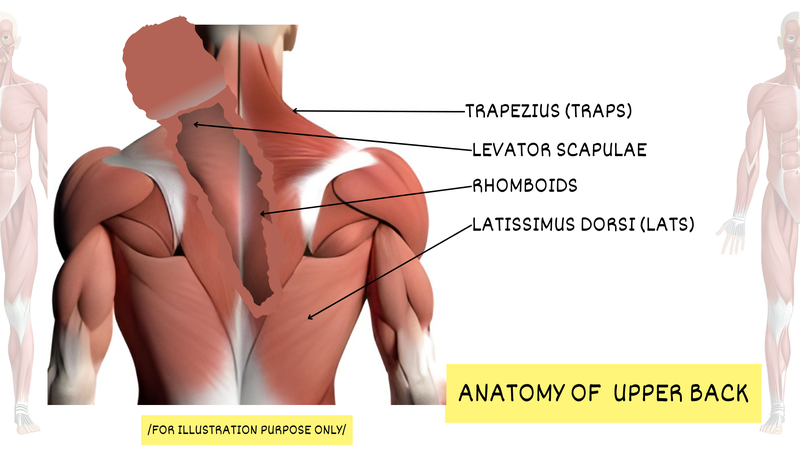7 Best Dumbbell Exercises for a Stronger Upper Back
The upper back is a vital area of the body that often gets overlooked in fitness routines, yet it plays a significant role in overall posture, stability, and strength.
Strengthening the upper back not only enhances athletic performance but also helps prevent injuries and alleviate discomfort associated with poor posture.
With the increasing prevalence of sedentary lifestyles and prolonged sitting, it’s more important than ever to incorporate targeted exercises that can effectively engage and strengthen this area.
Dumbbell exercises, in particular, offer a versatile and accessible way to build upper back strength, making them an excellent choice for individuals of all fitness levels.
In this article, we’ll explore the benefits of focusing on upper back workouts and how dumbbells can help you achieve your strength training goals.
Best Upper Back exercises with dumbbell
Incorporating dumbbell exercises into your routine can greatly enhance upper back strength and posture. These exercises target key muscle groups, promoting better stability and balance.
Focusing on controlled movements allows for greater muscle engagement, which can lead to improved definition and endurance.
Additionally, utilizing a variety of grips and angles can help prevent workout monotony and guarantee a thorough workout that addresses all areas of the upper back.
Regular practice not only aids in muscle development but also contributes to overall upper body functionality.
Dumbbell Reverse Fly
The Dumbbell Reverse Fly is an excellent exercise for targeting the upper back, specifically the rear deltoids and the rhomboids. This movement not only helps improve posture by strengthening these muscles but also enhances overall shoulder stability.
Incorporating this exercise into your routine can contribute to a balanced physique and alleviate tension that often accumulates in the upper back due to poor posture or prolonged sitting.
To perform the Dumbbell Reverse Fly effectively, follow these steps:
- Start by standing with your feet shoulder-width apart, holding a dumbbell in each hand.
- Hinge at the hips while keeping your back straight, allowing the dumbbells to hang down in front of you with your palms facing each other.
- With a slight bend in your elbows, raise the dumbbells out to the sides until they’re parallel to the ground, squeezing your shoulder blades together at the top of the movement.
- Lower the weights back to the starting position with control, ensuring that you maintain tension in your upper back throughout the exercise.
Dumbbell Face Pull
The dumbbell face pull is an excellent exercise for targeting the upper back, particularly the rear deltoids and the muscles of the upper trapezius.
This movement helps improve posture and shoulder stability, making it a great addition to any upper back workout routine. By strengthening these muscles, you can enhance overall upper body strength and reduce the risk of shoulder injuries, especially for those who spend long hours sitting or working at a desk.
To execute the dumbbell face pull correctly, follow these steps:
- Stand with your feet shoulder-width apart and hold a dumbbell in each hand.
- Bend slightly at the knees and hinge forward at the hips, keeping your back straight.
- Extend your arms straight in front of you at shoulder height, holding the dumbbells with an overhand grip.
- Pull the dumbbells towards your face, keeping your elbows high and flaring them outward.
- Squeeze your shoulder blades together at the top of the movement, then slowly return to the starting position.
Dumbbell Shrug
The dumbbell shrug is an effective exercise targeting the upper back, specifically the trapezius muscles, which play a vital role in shoulder stability and posture.
This exercise not only helps to build strength in the upper back but also enhances the overall aesthetics of the upper body by promoting well-defined shoulders and neck.
Incorporating dumbbell shrugs into your workout routine can also aid in alleviating tension in the neck and upper back, making it a valuable addition for those who spend long hours sitting or performing repetitive movements.
To execute the dumbbell shrug correctly, follow these steps:
- Stand upright with a dumbbell in each hand, arms fully extended at your sides.
- Keep your feet shoulder-width apart and maintain a neutral spine.
- Inhale, and as you exhale, raise your shoulders towards your ears, squeezing your traps.
- Hold the peak contraction for a moment at the top of the movement.
- Slowly lower your shoulders back to the starting position while inhaling.
Dumbbell Bent-Over Row
The Dumbbell Bent-Over Row is an excellent exercise for targeting the upper back muscles, particularly the latissimus dorsi, rhomboids, and trapezius.
This exercise not only helps in building strength and definition in the upper back but also improves posture by counteracting the effects of prolonged sitting and slouching.
Incorporating the bent-over row into your routine can enhance your overall upper body strength, making it a staple for anyone looking to develop a well-rounded physique.
To perform the Dumbbell Bent-Over Row effectively, follow these steps:
- Stand with your feet shoulder-width apart, holding a dumbbell in each hand.
- Bend your knees slightly and hinge at the hips to lean your torso forward, keeping your back straight and parallel to the ground.
- Let the dumbbells hang down at arm’s length, palms facing each other.
- Pull the dumbbells towards your hips, squeezing your shoulder blades together at the top of the movement.
- Lower the dumbbells back to the starting position with control, ensuring your back remains straight throughout the exercise.
Dumbbell Single-Arm Row
The Dumbbell Single-Arm Row is an effective exercise for targeting the upper back muscles, including the latissimus dorsi, rhomboids, and trapezius. This exercise not only helps in building strength but also promotes better posture by engaging the muscles that retract the shoulder blades.
It’s an excellent choice for those looking to improve their upper body strength and enhance overall functional fitness. Additionally, the unilateral nature of the movement allows for addressing muscle imbalances and improving core stability as you engage your core to maintain balance during the exercise.
To execute the Dumbbell Single-Arm Row correctly, follow these steps:
- Start by placing your left knee and left hand on a bench for support, with your right foot firmly planted on the floor.
- Hold a dumbbell in your right hand, allowing it to hang straight down towards the ground.
- Keeping your back straight and core engaged, pull the dumbbell upwards towards your hip, squeezing your shoulder blade at the top of the movement.
- Lower the dumbbell back to the starting position in a controlled manner, ensuring not to round your back.
Dumbbell Incline Row
The Dumbbell Incline Row is an effective exercise for targeting the upper back muscles, particularly the rhomboids, trapezius, and rear deltoids.
By performing this exercise on an incline bench, you can engage these muscles more thoroughly while also reducing stress on the lower back compared to traditional bent-over rows. This variation allows for a greater range of motion and helps to improve muscle activation, making it an essential addition to any upper back workout routine.
To execute the Dumbbell Incline Row, follow these steps:
- Set an adjustable bench to a 30-45 degree incline and lie face down on it, ensuring your chest is supported.
- Hold a dumbbell in each hand with your arms fully extended towards the floor and your palms facing each other.
- Engage your core and keep your back straight as you pull the dumbbells up towards your torso, squeezing your shoulder blades together at the top of the movement.
- Lower the weights back to the starting position in a controlled manner, fully extending your arms before repeating the movement.
Dumbbell Prone Row
The Dumbbell Prone Row is an effective exercise specifically targeting the upper back muscles, including the rhomboids, trapezius, and latissimus dorsi. This movement not only enhances strength and muscle definition in the upper back but also plays a vital role in promoting better posture and alleviating tension in the shoulders.
By incorporating this exercise into your routine, you can build a strong foundation for overall upper body strength, which is essential for other lifts and daily activities.
To perform the Dumbbell Prone Row, follow these steps:
- Begin by lying face down on a bench or an elevated surface, ensuring your torso is supported while your arms hang straight down.
- Hold a dumbbell in each hand with a neutral grip (palms facing each other).
- Engage your core and squeeze your shoulder blades together as you pull the dumbbells towards your ribcage, maintaining a slight bend in your elbows.
- Hold the top position for a moment to maximize muscle contraction, then slowly lower the dumbbells back to the starting position.
Anatomy of the Upper Back muscle
The upper back consists primarily of the trapezius, rhomboids, and latissimus dorsi muscles, which play a critical role in maintaining posture and facilitating upper body movement.
The trapezius, a large muscle that extends from the base of the skull to the mid-back, is responsible for stabilizing the shoulder blades and supporting neck movement. Meanwhile, the rhomboids, located between the shoulder blades, assist in retracting the scapulae, while the latissimus dorsi contributes to arm movements and overall torso stability.
Understanding the anatomy of the upper back is essential for effectively targeting these muscles during workouts.
By incorporating dumbbell exercises that focus on this area, individuals can enhance upper body strength, improve posture, and reduce the risk of injury.
Strengthening the upper back not only supports athletic performance but also contributes to daily functional movements, promoting overall health and well-being.
Benefits of dumbbell Upper Back exercises
Dumbbell exercises for the upper back provide numerous benefits, including enhanced muscle development and functional strength. By engaging multiple muscle fibers and requiring greater stabilization, these exercises not only promote muscle growth but also reduce the risk of injury. This is particularly important for athletes and fitness enthusiasts looking to improve their overall performance and joint stability.
Additionally, using dumbbells for upper back workouts allows for unilateral training, which helps identify and correct any strength imbalances between sides. This balanced approach to muscle development leads to improved coordination, essential for effective movement patterns and athletic performance.
Important training variables to consider
When planning your upper back workout, consider important training variables like exercise selection, intensity, volume, and rest periods to maximize results. Each variable plays a significant role in your overall progress and effectiveness of your training routine.
Exercise selection is critical; choose dumbbell exercises that target various muscles in your upper back, such as rows and shrugs.
Intensity refers to the weight you’re lifting. It’s important to challenge yourself but make sure you maintain proper form to avoid injury. Aim for weights that push your limits while still allowing you to complete your sets.
Volume involves the number of sets and repetitions you perform. Generally, 3-4 sets of 8-12 reps are effective for building strength and muscle size.
Finally, don’t overlook rest periods. Allow 60-90 seconds of rest between sets to recover and prepare for the next round.
By keeping these variables in mind, you’ll create a more effective workout plan that aligns with your goals.
- Choose exercises that engage all upper back muscles.
- Use weights that challenge you without sacrificing form.
Sample Upper Back workout with dumbbell
A well-structured upper back workout using dumbbells can greatly improve strength, posture, and overall upper body performance. Incorporating a variety of exercises can target different muscle groups in the upper back, including the trapezius, rhomboids, and latissimus dorsi. Below is a sample upper back workout program that you can follow to effectively engage these muscles.
| Exercise | Sets | Reps | Rest |
|---|---|---|---|
| Dumbbell Bent Over Row | 3 | 10-12 | 60 seconds |
| Dumbbell Shrugs | 3 | 12-15 | 60 seconds |
| Dumbbell Reverse Fly | 3 | 10-12 | 60 seconds |
| Single-arm Dumbbell Row | 3 | 10-12 (each side) | 60 seconds |
| Dumbbell Pullovers | 3 | 10-12 | 60 seconds |
Make sure to warm up before starting the workout and cool down afterward to prevent injuries and aid recovery. Adjust the weights according to your fitness level, and focus on maintaining proper form throughout each exercise for best results.
Questions
How Often Should I Train My Upper Back With Dumbbells?
You should train your upper back with dumbbells about two to three times a week. This frequency allows for proper recovery while promoting strength gain, ensuring you’re not overtraining and risking injury. Listen to your body!
Can Beginners Perform These Dumbbell Exercises Safely?
Yes, you can perform these dumbbell exercises safely as a beginner. Start with lighter weights, focus on your form, and gradually increase resistance. Listen to your body, and don’t hesitate to modify movements if needed.
What Are Common Mistakes to Avoid During Upper Back Workouts?
When working out your upper back, avoid using too much weight, neglecting form, and rushing through reps. Keep your movements controlled, focus on engaging the right muscles, and remember to warm up properly beforehand.
Should I Warm up Before Doing Upper Back Exercises?
Yes, you should definitely warm up before upper back exercises. It prepares your muscles, improves flexibility, and reduces injury risk. A few minutes of dynamic stretching or light cardio can make a big difference.
How Do I Know if I’m Using the Correct Weight?
To determine if you’re using the correct weight, focus on your form. If you can complete your reps without compromising technique but feel challenged, you’re likely on the right track. Adjust as needed!
Conclusion
Incorporating dumbbell exercises into your routine is a game-changer for building a stronger upper back. Not only do these movements target key muscles, but they also enhance your posture and stability, which can lead to better overall performance.
Remember to focus on proper form and gradually increase the weight as you progress. By committing to these exercises, you’ll reduce injury risk and promote muscle balance, making your workouts more effective and enjoyable.
Start strengthening your upper back today!








